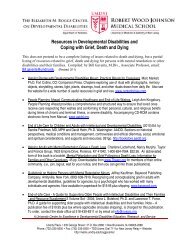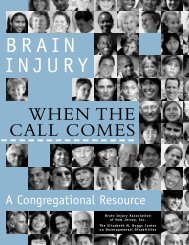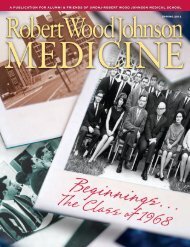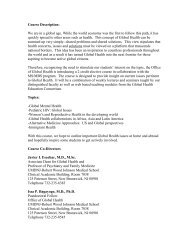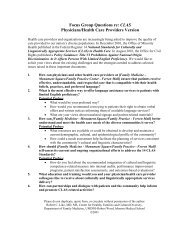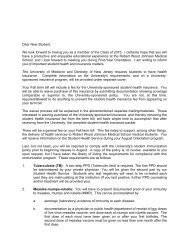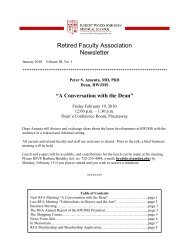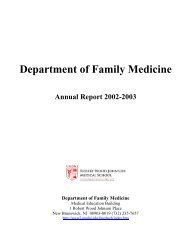Robert Wood Johnson Medicine • Spring 2011 • Population Science
Robert Wood Johnson Medicine • Spring 2011 • Population Science
Robert Wood Johnson Medicine • Spring 2011 • Population Science
Create successful ePaper yourself
Turn your PDF publications into a flip-book with our unique Google optimized e-Paper software.
“We are building on the great foundation of trauma at RWJMS. Using a surgical perspective to evaluate patients, our goal is to create a cohesive system,<br />
integrating every level of care involved in trauma and critical care,” says Vicente H. Gracias, MD, professor of surgery, chief, division of trauma/surgical critical<br />
care, and medical director, trauma and surgical critical care at RWJUH.<br />
part of surgery,” she says. “But I found<br />
emergency medicine more user-friendly.<br />
I like talking to people, taking their history,<br />
and thinking about the possible<br />
processes.”<br />
On her first day in the department, Dr.<br />
Gale gets what she had hoped for: not<br />
the melodramatic scenarios of the<br />
recent television series E.R., but rather<br />
the opportunity to help care for patients<br />
whose symptoms do not necessarily add<br />
up to a clear diagnosis.<br />
Today, assigned to the emergent —<br />
or sickest — side of the department,<br />
Dr. Gale meets six patients with six<br />
different problems. She also meets new<br />
colleagues: attending physicians and<br />
community physicians, nurses, technicians,<br />
and others who contribute to<br />
the department’s high standard of<br />
patient care. She begins mastering<br />
the basics: computerized order entry,<br />
the phone system, and the template<br />
for patient histories.<br />
At every step, Dr. Gale reports to<br />
<strong>Robert</strong> Eisenstein, MD, associate professor<br />
and vice chair, Department of<br />
Emergency <strong>Medicine</strong>, who helps her<br />
develop an evidence-based plan for<br />
each patient.<br />
Following is a partial log<br />
of Dr. Gale’s first day in the<br />
Emergency Department:<br />
➔ 10:20 A.M.: Dr. Eisenstein<br />
asks Dr. Gale to perform an endotracheal<br />
intubation on an intoxicated<br />
young man with a possible head injury<br />
and altered level of consciousness.<br />
She tries but is unable to perform the<br />
difficult procedure on the patient,<br />
whose neck must remain stabilized.<br />
Dr. Gale asks Dr. Eisenstein for help<br />
and watches as he quickly intubates<br />
the patient, demonstrating how it can<br />
be done successfully under these<br />
challenging circumstances.<br />
➔ 11:10 A.M.: Dr. Gale sees a<br />
woman in her 70s who suffered a serious<br />
fall while visiting her daughter,<br />
who lives locally. Despite her mother’s<br />
reluctance, the daughter brought her<br />
to the hospital. The patient’s face is a<br />
sea of bruises. She is in pain, vague,<br />
depressed, and somewhat disoriented.<br />
The daughter explains that her mother,<br />
who suffers from multiple sclerosis,<br />
has had many falls, adding, “She lives<br />
alone and wants to remain independent.”<br />
Dr. Gale reviews the case with<br />
Dr. Eisenstein and plans what tests to<br />
order. He discusses the importance of<br />
looking for acute injury but also<br />
emphasizes that the patient’s MS raises<br />
the likelihood that she has suffered<br />
earlier injury from recurrent falls. Dr.<br />
Eisenstein agrees with Dr. Gale’s plan<br />
to order a CT scan to rule out brain injury<br />
or broken bones and reminds her,<br />
“Always give the radiologist an idea of<br />
— Continued on Page 44<br />
<strong>Robert</strong> <strong>Wood</strong> <strong>Johnson</strong> ■ MEDICINE 43






